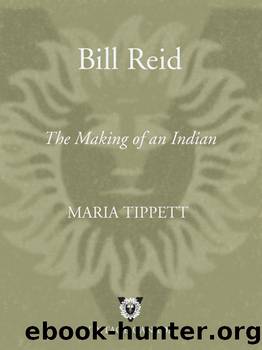Bill Reid by Maria Tippett

Author:Maria Tippett [Tippett, Maria]
Language: eng
Format: epub
ISBN: 978-0-307-36601-6
Publisher: Random House of Canada
Published: 2003-11-14T16:00:00+00:00
Sherry Grauer in Montreal, 1970
Reid envied Grauerâs freedom of expression because, as he told her, âthe sort of thing he did required more planning.â Her imaginative use of a wide variety of materials, along with her involvement in the hands-on process of making art, loosened up Reidâs approach to his own work and thereby expanded his artistic vision.21 Not long after they met, Bill and Sherry became lovers.
Before Reid moved into Grauerâs spacious second-floor apartment on Park Avenue, they took a trip to New York. Reid was anxious to show Tak Tanabe, who was now living there, and his patrons Adelaide de Menil and Edmund Carpenter what he had produced in London. It was supposed to be a short trip: a reunion with old friends, a chance to show off his new woman, and maybe even an opportunity to pick up a jewellery commission. But it turned into a nightmare.
Reid and Grauer arrived at the American border in Utica, New York, at 6:30 P.M. on September 10, 1969. The customs official asked them if they had anything to declare. The answer was no. Seeing a piece of Reidâs gold jewellery on the dashboard â a gold bracelet-watch that he had made at the Central in London â the customs officialâs eyes, according to Grauer, ânearly popped out.â He then asked the couple if he could inspect their luggage. His search revealed another piece of jewellery: it was the remarkable gold and diamond necklace that Reid had made in London. Reid was flattered by the customs officialâs interest in his work. Thinking he would like to see more, Reid naively said, âI have some more jewellery.â He then produced a pair of gold cufflinks and a few other pieces of jewellery that he had stored in his shaving kit. Convinced that Reid was embarking on more than a pleasure weekend to New York, the official ushered him into the customs office. Reid was asked to empty his pockets. This disclosed a gold bracelet. (It was in Reidâs pocket because he was self-conscious about wearing it with a short-sleeved shirt.) Further inspection of Reidâs car revealed an attaché case. It contained even more jewellery. There was the gold finial he had made at the Central and a small silver Haida bracelet that belonged to the New York collector George Terasaki. Expecting to find even more jewellery, the customs officials told Reid to strip and searched his clothing. No other pieces of jewellery were found.
Reid had initially told the customs officials that all the items were his. Further interrogation, however, brought out the truth. He did not own the old silver Haida bracelet but was returning the repaired work to George Terasaki. This, along with a cheque for $1,000 from Adelaide de Menil, aroused further suspicion. More customs officials arrived on the scene and more questions were asked. âWhy did you not declare the jewellery before entering the United States?â âDo you intend to sell the jewellery in New York?â âWhy did you
Download
This site does not store any files on its server. We only index and link to content provided by other sites. Please contact the content providers to delete copyright contents if any and email us, we'll remove relevant links or contents immediately.
Einstein: His Life and Universe by Walter Isaacson(1985)
Finding Freedom: Harry and Meghan and the Making of a Modern Royal Family by Omid Scobie & Carolyn Durand(1367)
Promised Land (9781524763183) by Obama Barack(1323)
Finding Freedom by Omid Scobie(1272)
Compromised by Peter Strzok(1243)
JFK by Fredrik Logevall(1135)
Freedom by Sebastian Junger(837)
The Russia House by John Le Carré(798)
Salford Lads: The Rise and Fall of Paul Massey by Bernard O'Mahoney(749)
The Irish Buddhist by Alicia Turner(741)
Day of the Dead by Mark Roberts(739)
Kremlin Winter by Robert Service(695)
Graveyard (Ed & Lorraine Warren Book 1) by Ed Warren & Lorraine Warren & Robert David Chase(693)
A World Ablaze by Craig Harline(687)
Joe Biden: American Dreamer by Evan Osnos(658)
Flying Tiger by Samson Jack(650)
Melania and Me: The Rise and Fall of My Friendship With the First Lady by Stephanie Winston Wolkoff(627)
100 Things Successful Leaders Do by Nigel Cumberland(626)
The Mission by David W. Brown(613)
